
Euphorbia is a very large and diverse genus of flowering plants, commonly called spurge, in the spurge family (Euphorbiaceae). "Euphorbia" is sometimes used in ordinary English to collectively refer to all members of Euphorbiaceae, not just to members of the genus. Some euphorbias are commercially widely available, such as poinsettias at Christmas. Some are commonly cultivated as ornamentals, or collected and highly valued for the aesthetic appearance of their unique floral structures, such as the crown of thorns plant. Euphorbias from the deserts of Southern Africa and Madagascar have evolved physical characteristics and forms similar to cacti of North and South America, so they are often incorrectly referred to as cacti. Some are used as ornamentals in landscaping, because of beautiful or striking overall forms, and drought and heat tolerance.

Joseph Marie Henry Alfred Perrier de la Bâthie was a French botanist who specialized in the plants of Madagascar.

Euphorbia heterophylla, also known under the common names of (Mexican) fireplant, painted euphorbia, Japanese poinsettia, desert poinsettia, wild poinsettia, fire on the mountain, paintedleaf, painted spurge, milkweed, and kaliko plant, is a plant belonging to the Euphorbiaceae or spurge family.
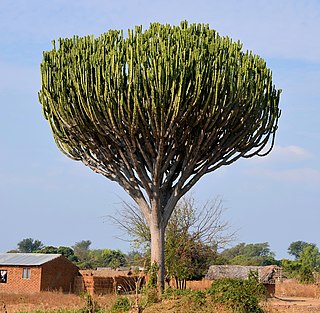
Euphorbia ingens is a species of flowering plant in the family Euphorbiaceae. It is native to dry areas of southern Africa. It is popularly known as the candelabra tree or naboom, and its milky latex can be extremely poisonous, and a dangerous irritant.
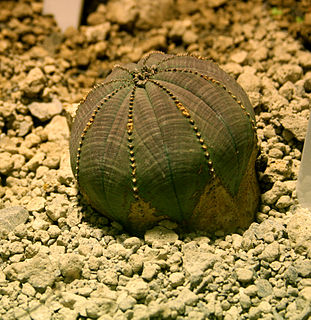
Euphorbia obesa is a subtropical succulent species of flowering plant in the genus Euphorbia. It comes from South Africa, especially the Cape Province. Sometimes referred to as the baseball plant.
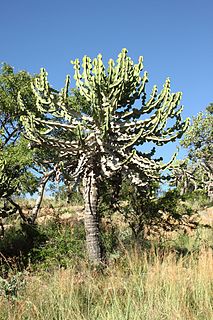
Euphorbia cooperi is a flowering plant in the Euphorbiaceae family. It is commonly called Transvaal candelabra tree or bushveld candelabra euphorbia, and is found in South Africa.
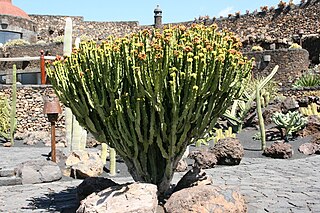
Euphorbia abyssinica, commonly known as the desert candle or candelabra spurge, is a species of plant in the family Euphorbiaceae. E. abyssinica is endemic to Ethiopia, Somalia, Sudan and Eritrea. It was first described in 1791, by the German botanist Johann Friedrich Gmelin. In its native habitat, it can grow up to 10 m (33 ft) tall. The woody stem is used for firewood and as timber in roofing, furniture and other items, and the sap is used in traditional medicine. It is also cultivated as an ornamental house plant.
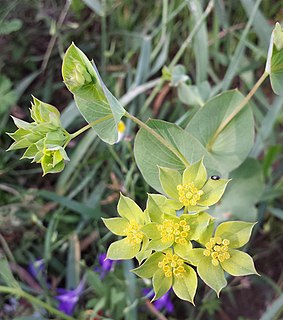
Bupleurum rotundifolium, hare's ear or hound's ear, is a species of flowering plant in the genus Bupleurum, native to Morocco, Algeria, southern, central and eastern Europe, Turkey, Iran, Turkmenistan, and Kyrgyzstan. Successful in disturbed areas, it is now an established weed in the eastern United States, and in South Africa, and is introduced elsewhere.
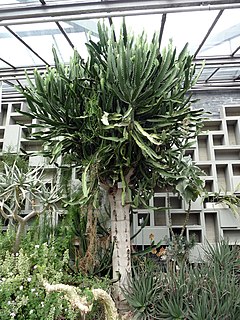
Euphorbia triangularis, commonly known as river euphorbia, chandelier-tree or tree euphorbia, is a species of plant in the family Euphorbiaceae native to southern Africa.

Euphorbia globosa, commonly known as globose euphorbia or globose spurge, is a species of plant in the family Euphorbiaceae native to southern Africa.

Euphorbia groenewaldii is a species of flowering plant in the family Euphorbiaceae native to southern Africa. It is listed as endemic to and Critically Endangered in South Africa due to habitat destruction and overcollection. Kew's Plants of the World Online also lists it as native to Mozambique.

Euphorbia grandidens, commonly known as valleybush euphorbia or large-toothed euphorbia, is a species of plant in the family Euphorbiaceae native to southern Africa.

Euphorbia mauritanica, commonly known as yellow milk bush or golden spurge, is a species of plant in the family Euphorbiaceae native to Africa.
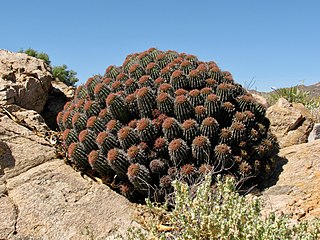
Euphorbia stellispina is a species of flowering plant in the family Euphorbiaceae endemic to southern Africa. It is locally known in Afrikaans as skaapnoors, sterretjie-noors, or Karoo noorsdoring. Euphorbia stellispina grows in rocky areas of karroid shrublands.

Euphorbia meloformis, called the melon spurge, is a species of flowering plant in the genus Euphorbia, native to the Cape Provinces of South Africa. A succulent, it has gained the Royal Horticultural Society's Award of Garden Merit.

Euphorbia grandialata is a species of flowering plant in the family Euphorbiaceae. It is endemic to South Africa in the Northern Cape. It was named by Robert Allen Dyer, in 1937.
Heldreichia is a monotypic genus of flowering plants belonging to the family Brassicaceae. It only contains one species, Heldreichia bupleurifoliaBoiss.

Mathiasella is a monotypic genus of flowering plants belonging to the family Apiaceae. It is in the Tribe Selineae. The genus only contains one known species, Mathiasella bupleuroidesConstance & C.L.Hitchc.
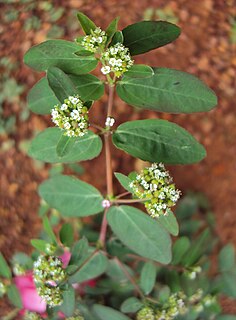
Euphorbia hypericifolia is a species of perennial herb in the genus Euphorbia native to tropical Americas. It can grow up to 2 feet (0.6 m) in height, and contains milky sap which can cause skin and eye irritation.
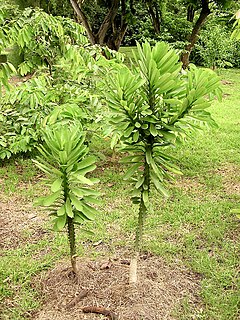
Euphorbia nivulia is a subtropical succulent species of flowering plant in the family Euphorbiaceae. It is found in the Indian subcontinent and is commonly known as the leafy milk hedge, holy milk hedge or dog's tongue.



















